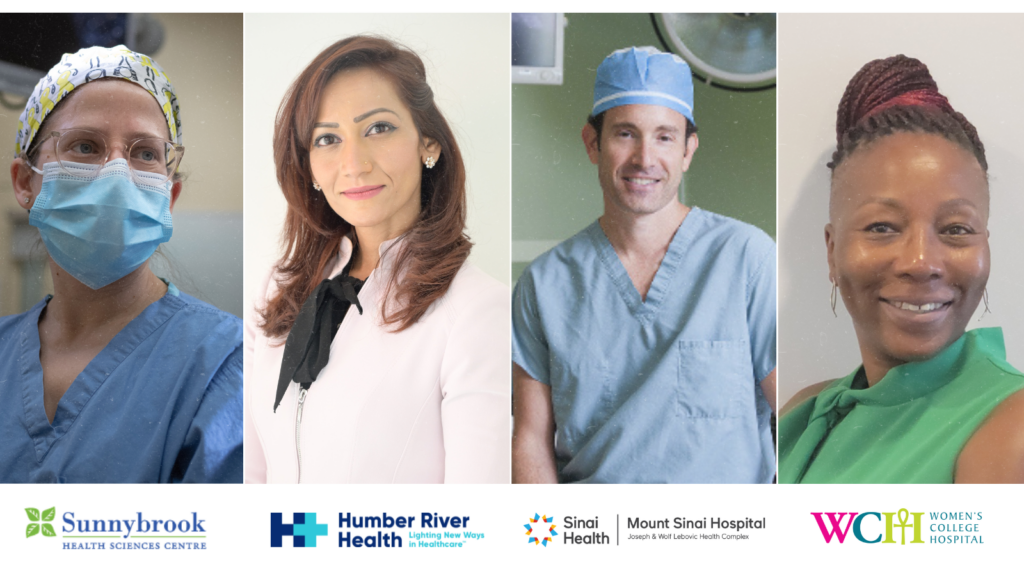
Flora Kestin lived with undiagnosed endometriosis for 15 years. The heavy bleeding and crippling pain resulted in Flora’s regular activities as a busy parent almost coming to a halt at least two weeks of every month.
In 2020, Flora learned about Dr. Jamie Kroft, a Sunnybrook obstetrician gynecologist specializing in endometriosis, a condition which mirrored her severe symptoms. Three years later, the 27-year-old received an appointment for a consult at Sunnybrook.
Flora’s experience isn’t unusual; surgical backlogs for many benign surgeries in Ontario have been amplified by pandemic restrictions. A post-pandemic focus on other priority programs such as total joints, cataract and pediatric surgery has only exacerbated the issue for some, including those needing benign gynecological surgery.
Now, a collaborative initiative between four Toronto Academic Health Science Network (TAHSN) hospitals – Women’s College Hospital (WCH), Sunnybrook Health Sciences Centre, Mount Sinai Hospital, and Humber River Health (HRH) – has successfully launched the first phase of a project aimed at tackling the backlog for these surgeries in the Toronto region. Using funding received through the Ontario Ministry of Health’s Surgical and Diagnostic Imaging Efficiency & Innovation Initiative, the WCH and HRH led initiative is on track to have surpassed its initial target of completing 335 benign gynecological surgeries in just three months. This represents over 29 per cent of Ontario patients who have surpassed their surgical wait time targets, also known as long waiters, as of December 2023.
“This project capitalized on available operating room (OR) capacity at WCH and HRH, making strategic partnerships with other Toronto area hospitals vital,” says Sandra Robinson, director of perioperative services at WCH and a program lead for the initiative. “Surgeons from collaborating hospitals leveraged free OR time to perform benign gynecological surgeries, allowing us to collectively address and begin to overcome our surgical backlog.”
This program marks a pivotal step in advancing recovery efforts aimed at reducing surgical wait times for patients who have surpassed the maximum clinical access target for benign gynecological surgeries.
“As part of the journey to recovering surgical capacity across the GTA, this four hospital collaboration supports utilizing existing infrastructure by sharing resources to address women’s health. This partnership is a true testimony to integrating care across sites to address not just the surgical backlog but also focus on different populations using an equity, diversity and inclusion lens.,” added Jhanvi Solanki, vice president of clinical programs at Humber River Health. “It is so great to participate in this initiative that prioritizes women’s health.”
For Flora, the initiative has made a world of difference. On February 12, 2024, she had surgery with Dr. Kroft at Women’s College Hospital. “I haven’t had any pain and my mobility has really improved,” she says. “And it goes past that; I feel much more calm, like my nervous system is more relaxed.”
Dr. Kroft has seen firsthand the frustration of patients waiting for long periods to see a specialist, compounded further by the fact that many are in considerable pain.
“This partnership has made strides in improving how quickly we treat patients in need of gynecology procedures,” says Dr. Kroft. “With strong support from the government, hospitals have been able to work together to address waitlists now, and hopefully in the future, in a sustainable way.”
Phase two of the program will see the establishment of a centralized intake model for benign gynecological cases, streamlining patient referrals and enhancing access to care across the Toronto region. This approach will also align appointments with the next available surgeon and provide options for primary care physicians to select preferred providers. By establishing a centralized intake model, the program will enhance patients’ access to care while allowing them to stay closer to home.
While the centralized intake model will continue to address issues surrounding surgical backlog, program leads are hopeful that continued program implementation and support will allow Toronto region hospitals to continue to overcome the benign gynecology long waiter list.
“Thanks to this funding from the Ministry of Health, we’ve been able to take a strategic approach to tackling healthcare challenges through joint solutions,” says Robinson. “Through targeted investments and cooperative efforts, this program exemplifies a commitment to driving innovation in surgical care delivery. We are creating a foundation that confronts surgical wait times and builds a new healthcare model for the future, rooted in collaboration.”